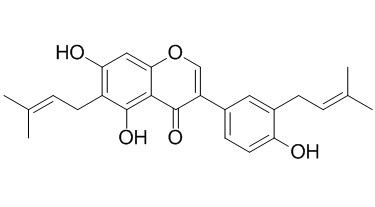Lupalbigenin
Lupalbigenin sensitizes detachment-induced cell death in human lung cancer cell through down-regulation of pro-survival proteins.Lupalbigenin, laburnetin , and isolupalbigenin show promising cytotoxic effects toward HL-60 cells (IC50 4.3 ± 0.7 to 18.0 ± 1.7 uM).
Inquire / Order:
manager@chemfaces.com
Technical Inquiries:
service@chemfaces.com
Tel:
+86-27-84237783
Fax:
+86-27-84254680
Address:
1 Building, No. 83, CheCheng Rd., Wuhan Economic and Technological Development Zone, Wuhan, Hubei 430056, PRC
Providing storage is as stated on the product vial and the vial is kept tightly sealed, the product can be stored for up to
24 months(2-8C).
Wherever possible, you should prepare and use solutions on the same day. However, if you need to make up stock solutions in advance, we recommend that you store the solution as aliquots in tightly sealed vials at -20C. Generally, these will be useable for up to two weeks. Before use, and prior to opening the vial we recommend that you allow your product to equilibrate to room temperature for at least 1 hour.
Need more advice on solubility, usage and handling? Please email to: service@chemfaces.com
The packaging of the product may have turned upside down during transportation, resulting in the natural compounds adhering to the neck or cap of the vial. take the vial out of its packaging and gently shake to let the compounds fall to the bottom of the vial. for liquid products, centrifuge at 200-500 RPM to gather the liquid at the bottom of the vial. try to avoid loss or contamination during handling.
Cancers (Basel).2023, 15(1):37.
Anal Bioanal Chem.2023, 415(9):1641-1655.
Arabian Journal of Chemistry2024, 17(3):105648
Molecules.2024, 29(6):1392.
Plants (Basel).2021, 10(7):1376.
Food Science&Tech. Res.2022, 28(2):123-132.
Biosci. Rep.2020, 10.1024
Appl. Sci.2021, 11(1),14.
Neuropharmacology2019, 151437
Phytomedicine2022, 104:154337.
Related and Featured Products
J Asian Nat Prod Res. 2017 May;19(5):510-518.
Prenylated isoflavones from Cudrania tricuspidata inhibit NO production in RAW 264.7 macrophages and suppress HL-60 cells proliferation.[Pubmed:
27649772 ]
METHODS AND RESULTS:
Inhibitory effects of NO production in RAW 264.7 macrophages guided the isolation of nine prenylated isoflavones, including a new cudraisoflavone L (1) and eight known metabolites furowanin B (2), erysubin A (3), wighteone (4), Lupalbigenin (5), laburnetin (6), isoLupalbigenin (7), 6,8-diprenylorobol (8), millewanin H (9) from the leaves of Cudrania tricuspidata.
CONCLUSIONS:
At the concentration of 10 μM, compounds 1, 2, and 4 significantly inhibited NO production with the inhibitory values of 72.5 ± 2.4, 66.9 ± 1.8, and 55.4 ± 2.7%, respectively. In addition, all of isolated compounds 1-9 showed promising cytotoxic effects toward HL-60 cells (IC50 4.3 ± 0.7 to 18.0 ± 1.7 μM).
Anticancer Res. 2015 May;35(5):2827-34.
Lupalbigenin from Derris scandens Sensitizes Detachment-induced Cell Death in Human Lung Cancer Cells.[Pubmed:
25964563 ]
The ability of cancer cells to resist to anoikis has been shown to augment cancer cell metastasis in many cancers. In search for potential substances for anti-metastatic approaches, this study aimed to investigate anoikis-sensitizing activity of Lupalbigenin, extracted from Derris scandens.
METHODS AND RESULTS:
Human lung cancer cells were treated with non-cytotoxic concentrations of Lupalbigenin in a detachment condition. Anoikis was evaluated at various time points using MTT viability assays. The effect of Lupalbigenin on anchorage-independent growth was performed by soft-agar assay. The survival signaling proteins, as well as regulatory proteins of apoptosis and metastasis, were examined by western blot analysis. Lupalbigenin treatment significantly down-regulated survival proteins, including protein kinase B (pAKT/AKT) and extracellular signal-regulated kinase (pERK/ERK), as well as anti-apoptotic protein B-cell lymphoma 2 (BCL-2), resulting in the enhancement of the cellular response to anoikis and the decrease of growth and survival in an anchorage-independent condition.
CONCLUSIONS:
Lupalbigenin sensitizes detachment-induced cell death in human lung cancer cell through down-regulation of pro-survival proteins.
Biol Pharm Bull. 2016;39(4):631-5.
Bioassay-Guided Isolation of Two Flavonoids from Derris scandens with Topoisomerase II Poison Activity.[Pubmed:
26754253 ]
Derris scandens (ROXB.) BENTH. (Fabaceae) is used as an alternative treatment for cancer in Thai traditional medicine. Investigation of the topoisomerase II (Top2) poison of compounds isolated from this plant may reveal new drug leads for the treatment of cancer.
METHODS AND RESULTS:
Bioassay-guided isolation was performed on an extract of D. scandens stems using a yeast cell-based assay. A yeast strain expressing the top2-1 temperature-sensitive mutant was used to assay Top2 activity. At the permissive temperature of 25°C, yeast cells were highly sensitive to Top2 poison agents. At the semi-permissive temperature of 30°C, where enzyme activity was present but greatly diminished, cells displayed only marginal sensitivity. The bioassay-guided fractionation of the extract led to the isolation of two known isoflavones: 5,7,4'-trihydroxy-6,8-diprenylisoflavone (1) and Lupalbigenin (2). These two compounds also displayed cytotoxicity against three different cancer cell lines, KB, MCF-7 and NCI-H187.
CONCLUSIONS:
In conclusion, Top2 poison agents from D. scandens are reported for the first time, substantiating the use of D. scandens in Thai traditional medicine for cancer treatment.



